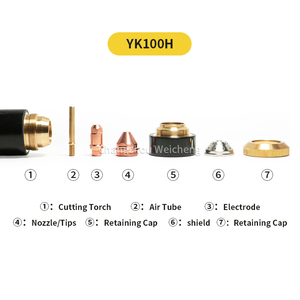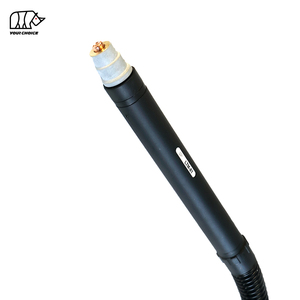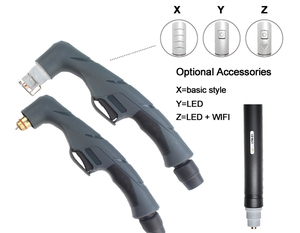
All categories
Featured selections
Trade Assurance
Buyer Central
Help Center
Get the app
Become a supplier

(4835 products available)


















































A CNC plasma cutter torch entails specific plasma cutter components, which are affected by the configurations needed for different tasks. Below are the most common ones:
The electrode focuses the electric arc to generate plasma. Usually, an electrode is made of copper tungsten or hafnium because of their ability to withstand extreme heat. In addition, the materials help enhance the plasma arc concentration for cleaner and more precise cutting. Electrode wear can impact efficiency; hence, frequent checks for wear and replacement dog ears for signs of erosion are crucial.
A nozzle, with its constricting opening, shapes the plasma arc. Typically, nozzles are made from copper or brass, with each material providing different thermal conductivities. While brass nozzles offer better corrosion resistance and are cheaper, copper provides better heat conductivity, which is essential for maintaining plasma temperature. Also, nozzle sizes vary; smaller sizes offer cleaner cuts, while larger ones are suitable for faster cutting but may lessen precision.
Swirl rings are responsible for the plasma and gas inward swirls before exiting the nozzle. Normally, they are constructed with notched ceramic or insulator material. The notches help control the plasma arc by ensuring it has the right shape and consistency. Typically, a well-functioning swirl ring ensures the plasma arc has the proper stability and form. This provides cuts with necessary accuracy and smoothness.
The electrode holder securely holds the electrode in place. Usually, it is made of durable materials like copper or brass. The main responsibility of the holder is to give a steady electric flow from the tip to the electrode. This ensures stable arc ignition. Besides that, a well-maintained holder helps in easy electrode replacement. In addition, it prevents unnecessary delays during plasma cutting operations.
The leads are electric lines connecting the plasma cutter to the torch. Most of them are constructed with copper grounds, which offer good conductivity. On the other hand, the cabinet is a protective and supportive structure for the plasma cutter's internal parts. In most cases, cabinets are constructed with steel, which ensures sturdy housing and protects components from debris and damage.
The return ring, located near the handle, provides a path for the plasma arc and assist generating a stabilizing gas flow. Most of them are made of durable ceramic. A well-functioning return ring gives the plasma arc a more circular pattern, enhancing its stabilizing capability. In case of wear or damage, the return ring should be replaced immediately to stop impacting cutting precision and arc stability adversely.
In metal fabrication, a CNC plasma torch is used to cut highly conductive metals like stainless steel, aluminum, and copper. This torch provides precision and speed, which are crucial to making complex shapes and parts required in varied industrial applications. In addition, plasma cutting offers clean edges and minimal heat-affected zones, greatly reducing the need for post-cutting finishing work in metal fabrication.
The CNC plasma torch is heavily employed in the automotive industry for diverse tasks like cutting body panels and chassis components. In this industry, where precision needs are a huge priority, the torch helps create intricate parts with high accuracy. It is also an efficient way of handling varied materials, including aluminum and stainless steel, which are commonly used in modern automotive designs.
The aerospace engineering industry needs high-precision cutting, something that the CNC plasma torch effectively provides. Therefore, it is used to cut assorted aircraft components from premium heat-resistant alloys and thickness materials. Its accuracy helps create parts that have close-tolerance requirements in this industry. Also, CNC plasma torches can easily be automated for complex repetitive cutting operations.
Plasma torches in shipbuilding greatly contribute to the cutting of massive steel sheets used in ship hull construction. In addition, the CNC torch's ability to handle varied material thicknesses make it ideal for this industry, as it may require both thin and thick steel plate cuts. Also, it allows for a higher level of production efficiency as it can consistently provide detailed cuts in a quick manner.
The CNC plasma torch also finds uses in art and design for creating detailed metal artwork or custom signs. It can cut intricate and elaborate designs from metal sheets, whether for artistic sculptures or functional decorative pieces. Its precision and ability to work with varied metal types allow artists to explore complex cutting patterns that might be difficult or impossible with traditional cutting methods.
In the construction industry, CNC plasma torches are commonly used to make components for structural frameworks, including beams and reinforcements. The speed and accuracy of plasma cutting, especially on thin metal sheets, make it valuable for producing standard building elements quickly. Also, it allows builders to work with various metals, including architectural components like steel and grids for structural integrity.
High Precision and Accuracy
The CNC plasma torch is engineered to provide exceptional accuracy in plasma cutting. Hence, this feature is particularly critical when dealing with intricate designs and tight tolerances usually encountered in diverse operations. In addition, the CNC technology allows for minutiae controlled movements, leading to clean cuts with minimal deviation from the planned cut path. Therefore, this precision ensures that the finished products meet stringent quality standards.
Automatic Cutting Process
CNC plasma torches carry out the cutting process automatically. This automation significantly enhances cutting efficiency since it reduces manual intervention needs. Additionally, it allows for quick and consistent production of detailed parts. Another advantage is that a CNC plasma torch can operate for long hours without requiring human supervision, making it ideal for massive production environments.
Variable Cutting Thickness
A CNC plasma cutter torch comes with a variable cutting thickness feature. Normally, it allows cutting of metals with different thickness levels, ranging from thin sheets to thicker plates. Thus, the flexibility makes it a valuable tool for multiple industries, as diverse projects commonly require varied thickness. Furthermore, it eliminates the necessity for multiple machines, saving space and capital investment.
Digital Controls
Typically, CNC plasma torches come with compatible design software input via digital signals. Thus, these digital controls allow precise manipulation of the plasma torch to follow the defined cutting path. In addition, it provides a high level of repeatability for mass production. Also, these controls enable quick adjustments to cutting parameters, thereby facilitating rapid responses to changing production needs.
Versatile Material Compatibility
Apart from gases like oxygen and nitrogen, CNC plasma torches can also cut metals like stainless steel, aluminum, and mild steel because they are electrically conductive. The ability to cut a broad spectrum of materials makes it a highly versatile tool, accommodating numerous tasks. Therefore, this versatility is also beneficial for different industries that require custom solutions for varied material requirements.
Mounting the Torch Holder
The first step during installation begins with mounting the torch holder onto the CNC machine or plasma table. One should ensure that the holder is aligned with the direction of cutting. In addition, the tightly secured nature of the holder will avoid any movements during cutting. Also, the height of the holder needs to be adjustable to ensure that the torch will be at the right distance from the metal plate.
Plasma Torch Attachment
This next step involves attaching the CNC plasma torch to the holder. In addition, the torch is usually fitted into a connector that is then secured by a locking clamp or screw. It is also important to make sure the electric leads from the torch connect to the cutter's output terminal. This ensures that the torch receives appropriate electricity to create the plasma arc.
Gas Connection
After attaching the torch, the next step is connecting the gas hoses. In addition, one should connect the oxygen and the retraining gas lines to the torch, as per the manufacturer’s guidance. This goes a long way in ensuring the torch is operating properly. Besides that, oxygen and nitrogen should be connected to the pressure regulator to set their proper working levels.
Wiring the CNC Machine
In this installation stage, the CNC machine is wired to the plasma cutter. Normally, the machine's control output is cabled to the plasma cutter's triggering input terminal. This will enable the CNC machine to control the torch during plasma cutting. It is also ideal for testing the machine and plasma cutter connections using a low power setting before performing an actual cut.
Working Area Verification
On completion of all these steps, one should do a final check after completing this installation. The check involves ensuring that the machine workspace is free from any obstacles or debris. Besides that, ensure the height set on the torch is appropriate for the material to be cut. The final pre-cut check is for loose wires or components that may cause accidents during working.
Regular Cleaning
Regular cleaning of the CNC plasma torch is important since it helps remove slag and metal dust accumulation, which may affect performance. One should use a brush or compressed air to clean the torch after each cutting session. In addition, cleaning helps ensures optimal cutting conditions and minimizes wear on the parts. Never use water or liquid cleaners, as they may damage electrical components inside the torch.
Inspections
One should do plasma torch components and parts inspections regularly for signs of wear, as this is critical to maintaining functionality. For instance, check the electrode for erosion and the nozzle for holes. Also, worn components should be replaced to avoid cutting errors or decreased performance. In addition, make broader inspections part of a preventative maintenance schedule work that limits downtime.
Proper Gas Mixture
Usually, improper gas mixtures lead to issues with arc stability and cutting quality. Thus, one should ensure that the gas mixture settings on the plasma cutter are always correct. In addition, routinely check pressure and gas types to conform with the manufacturer’s specifications. Besides that, it should maintain this mixture so the torch will operate properly and generate high-quality cuts.
Wear Parts Replacement
Common wear parts include electrodes and nozzles and should be frequently replaced to keep operational efficiency up to the cutting. In addition, it monitors these parts during routine inspections so they can be swapped out as soon as wear is detected. Moreover, using worn-out parts will result in poor cuts and increased time needed for completing tasks. Therefore, it helps ensure all parts are replaced timely.
Cooling
The CNC plasma torch usually has a cooling system that maintains its temperature during operation. Hence, ensure that the coolant level is adequate and that there are no leaks. Also, one should change or clean the cooling water frequently to remove heat buildup that may affect cutting performance. In addition, a well-maintained cooling system helps in prolonging torch life and consistent operation.
Assess Supplier Reliability
It is important to purchase CNC plasma torches from trustworthy suppliers with a proven customer and quality service record. Basically, reliable suppliers commemorate quality; they also have authentic OEM centers and aftermarket service records. Thus, it is important to buy from suppliers with certified factories with stable production capacities in various models.
Quality over Price
In this case, it is plasma cutters and torch parts. It can always be tempting to make cheap purchases, but there are better deals in this industry. The business's long-term profitability or success hinges on operational effectiveness. Thus, one has to invest in authentic CNC torches, for instance, a CNC plasma cutter table that will serve for cutting metals efficiently. It curtails replacements and repairs in the short run and offers purchases cost-effectiveness.
Request Samples
After selecting a potential supplier, one needs to ask for small and trial orders or samples for initial testing before making the final comprehensive purchase. Also, it helps with determining quality firsthand. Besides that, it gives one the chance to evaluate the after-sales service and shipping time. Be clear about the lead and sample order times to avoid misunderstandings.
Evaluate Product Range
Ensure the potential supplier stocks CNC plasma torches and parts in various sizes and in compatible hardware and software. This ensures supplier dependability when placing repetitive orders. Besides that, it gives the buyer an opportunity to change a bit or make enhancements to the CNC cutter over time. When starting, make sure there are such products as a CNC plasma cutter table.
Check Certifications
Suppliers usually have various certifications so they can comply with internationally accepted quality standards such as ISO. When they have such certifications, they are likely to have quality control processes that ensure product quality. In addition, using certified products goes a long way in giving customers confidence and satisfaction and also ensures that a business is run in compliance with safety regulations.
Negotiate Terms
There are times to negotiate payment and bulk order placement terms with suppliers regarding delivery times and product returns. It is always better to get clear contractual agreements on these essential deals as they build long-term business relationships. It might even lead to getting favorable prices in the future, which encourages overall cost effectiveness. Ensure these terms are reasonable and beneficial to both parties.
A1: A CNC plasma torch is basically a cutting tool that utilizes electrically ionized gas called plasma to cut metal with the aid of computer numerical control. In addition, it offers high precision and efficiency, especially for conducting large volume cuts.
A2: A CNC plasma torch can cut several metals like mild steel, stainless steel, aluminum, and copper but only if the metals are electrically conductive.
A3: CNC plasma cutting works by creating a plasma arc from a tungsten electrode to the workpiece with compressed gas. In addition, the CNC guides the torch along a preprogrammed path on the workpiece to make the desired cut.
A4: Some of the benefits of plasma cutting include speed, precision, suitability for varied material thicknesses, and the ability to cut complex shapes. Also, it offers clean edges and minimal heat-affected zones.
A5: CNC plasma torches can cut metal as thin as 1/32 inch to 1.5 inches. Nevertheless, this thickness range can vary based on the type of metal and plasma cutter used.
A6: There are numerous CNC plasma torches that are compact and lightweight; thus, they can easily be transported. In addition, some models are designed for handheld operations, making it more portable.
A7: To ensure safety during CNC plasma cutting, one has to wear appropriate personal protective equipment, including safety goggles, gloves, and a welding apron. Further, ensure there is adequate ventilation in the working area and keep flammable materials away from the cutting zone.